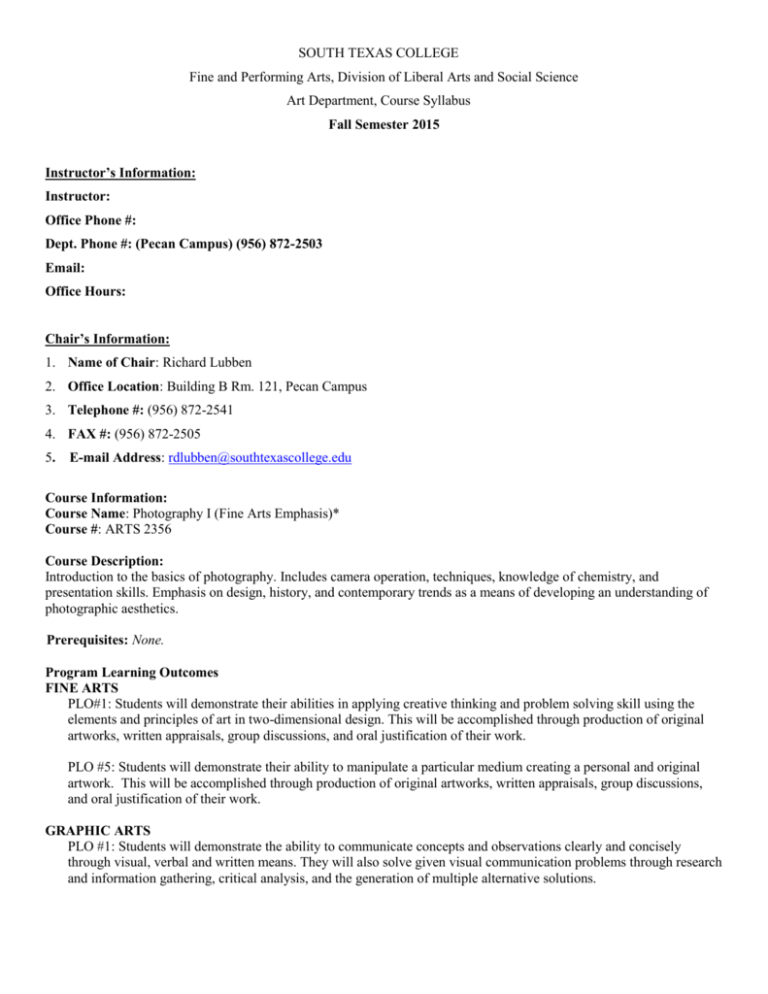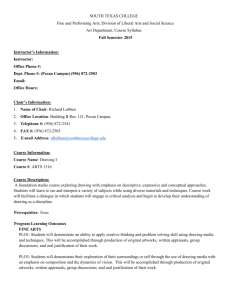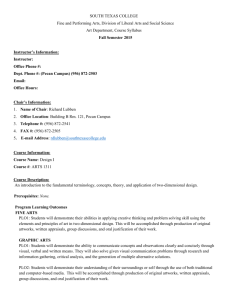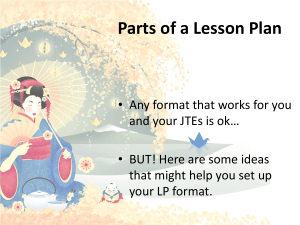ARTS2356 Master Syllabus - Texas Association of Schools of Art
advertisement

SOUTH TEXAS COLLEGE Fine and Performing Arts, Division of Liberal Arts and Social Science Art Department, Course Syllabus Fall Semester 2015 Instructor’s Information: Instructor: Office Phone #: Dept. Phone #: (Pecan Campus) (956) 872-2503 Email: Office Hours: Chair’s Information: 1. Name of Chair: Richard Lubben 2. Office Location: Building B Rm. 121, Pecan Campus 3. Telephone #: (956) 872-2541 4. FAX #: (956) 872-2505 5. E-mail Address: rdlubben@southtexascollege.edu Course Information: Course Name: Photography I (Fine Arts Emphasis)* Course #: ARTS 2356 Course Description: Introduction to the basics of photography. Includes camera operation, techniques, knowledge of chemistry, and presentation skills. Emphasis on design, history, and contemporary trends as a means of developing an understanding of photographic aesthetics. Prerequisites: None. Program Learning Outcomes FINE ARTS PLO#1: Students will demonstrate their abilities in applying creative thinking and problem solving skill using the elements and principles of art in two-dimensional design. This will be accomplished through production of original artworks, written appraisals, group discussions, and oral justification of their work. PLO #5: Students will demonstrate their ability to manipulate a particular medium creating a personal and original artwork. This will be accomplished through production of original artworks, written appraisals, group discussions, and oral justification of their work. GRAPHIC ARTS PLO #1: Students will demonstrate the ability to communicate concepts and observations clearly and concisely through visual, verbal and written means. They will also solve given visual communication problems through research and information gathering, critical analysis, and the generation of multiple alternative solutions. PLO#2: Students will demonstrate their understanding of their surroundings or self through the use of both traditional and computer-based media. This will be accomplished through production of original artworks, written appraisals, group discussions, and oral justification of their work. Course Learning Outcomes At the conclusion of the course students will: 1. Respond critically through various means to works in the arts and humanities. (CT) (GRAPHIC PLO#2) 2. Demonstrate the ability to develop, express, and communicate ideas in written, oral, and hands-on art projects. (COM) (FINE PLO#5) (GRAPHIC PLO#1) 3. Demonstrate their ability to work effectively with others in teams toward a shared purpose or goal. (TW) 4. Demonstrate an understanding of the purposes and functions of art as it relates to social responsibility, cultural diversity and civic responsibility through written, oral, and hands-on art projects. (SR) 5. Demonstrate their understanding of the formal components of two-dimensional art through verbal and/or written form. (FINE PLO#1) Required Core Objectives for Core Component Area CRITICAL THINKING SKILLS: to include creative thinking, innovation, inquiry, and analysis, evaluation and synthesis of information. COMMUNICATION SKILLS: to include effective development, interpretation and expression of ideas through written, oral and visual communication. TEAMWORK: to include the ability to consider different points of view and to work effectively with others to support a shared purpose or goal. SOCIAL RESPONSIBILITY: to include intercultural competence, knowledge of civic responsibility, and the ability to engage effectively in regional, national, and global communities. Department Required Common Assignment to Meet and Assess Core Objectives This assignment will be given in all sections and will use the Institutional Core Objective Grading Rubric for assessment of the core objectives. Each of these four (4) components listed below will be evaluated via provided rubrics as 25% of the total grade for the assignment: 1. (COM) Students will effectively express ideas in a written, visual artwork, and oral form. 2. (TW) Students will work in teams to complete the assignment, and will evaluate one another’s participation and communication in the process. Additionally, students will evaluate other team’s completed artwork. 3. (SR) Possible topics for social responsibility messages include, but are not limited to: social awareness, identity, gender, political and social beliefs, censorship, environmental issues, human rights and ethics. 4. (CT) The assignment will demonstrate the development, interpretation, and expression of the chosen topic, thus showing the student’s ability to synthesize information and think critically. Photo Essay Assignment: Working in teams, students will demonstrate an understanding of the purposes and functions of art as it relates to cultural diversity and civic and social responsibility. Student teams will research and reference a historical photographer of their choice and compare and contrast ideas of social responsibility of the photographer’s culture and time to the students’ present circumstances and beliefs. In the manner of the chosen photographer, students will develop a photo essay (thematically related and in a narrative series of images) that records/documents people in the local, national, or global community working toward making a positive change. For example, students could conduct a behind the scenes photo essay of a person(s) who engage in altruistic activities such as volunteering for a charitable cause. Students will examine and consider the different points of view of works of visual arts individually and in teams. Emphasis will be placed on working effectively with others to support a shared purpose or goal. Individual students will evaluate the participation and contribution of their teammates. These evaluations will count toward the individual’s grade. Utilizing critical thinking skills such as inquiry, analysis, evaluation, and synthesis of information, student teams will conduct research and uncover backstories of their subject. This can take the form of interviews, historical research, and other methods of journalistic reporting. Students will be required to work together to gather, analyze, evaluate, and synthesize the necessary background information before beginning the photographic aspect of this project. Utilizing a PowerPoint template provided by the instructor, student teams will orally and visually present their Photo Essay to the class. PowerPoint presentations will include 24 photographic images, with an even number of photos from each contributing team member. Additionally, a 250 word statement of intent and a 500 word synopsis of the project will be required of student teams. Your instructor will provide more details in class. Evaluation: Grading Criteria: A combination of oral assignments, written assignments, in-class or online quizzes/examinations, oral presentations, and classroom/online activities can be used to evaluate student performance. Each instructor will have at his/her discretion, the ability to combine the admixture to evaluate student performance. Students may display their level of understanding of the learning outcomes in several manners. The required department common assignment will be evaluated using the institutional core objective grading rubric. This course is designed to introduce a breadth of knowledge and reinforce cognitive, creative and problem solving skills. In addition to the evaluation of the artistic and creative aspects of work, no less than one-half of the student’s overall semester grade will be based on assignments and activities that focus on the appreciation and analysis of art including theory, criticism, aesthetics, design foundations, the interpretation of art and history. Required Textbook & Resources: Textbook Information: Light and Lens: Photography in the Digital Age. Robert Hirsch. Focal Press. Classroom Expectation: 1. Work on projects with emphasis on developing better communication, critical thinking and teamwork skills. 2. Gain familiarity with art terminology and tools as they relate to the fine art photography with a strong focus on the camera and Adobe editing software. 3. Demonstrate competency in basic photographic techniques such as exposure, filters, depth of field, etc., input devices such as digital cameras and scanners, and output devices such as printers. 3. Maintain a professional and respectful attitude. This includes but is not limited to meaningful participation in critiques and maintenance of classroom facilities and shared supplies. *Supplies Needed: Each instructor will list additional resources needed, or provide a list of supplies on an attached sheet. Additional material costs for paper and printing will be required in this course and is the responsibility of the student to purchase these materials when needed. Safety Statement: Students entering studio/lab classes should be aware that they may be exposed to potentially hazardous chemicals and equipment. The students should assume responsibility for conducting themselves in a manner to minimize such hazards. (It is in the best interest of the students who are pregnant to defer laboratory/studio classes until after delivery.) Complete the safety instructions on the STC VAM website provided by the instructor. Students must read the VAM Health and Safety Manual at the following link: http://lass.southtexascollege.edu/vam/safety/intro.html Download and print the CONSENT FORM from the appendices page. Sign the consent form and turn it in to your instructor. You must do so in order to attend class. STC Departmental Textbook and Supply Policy: All students must have the required materials including but not limited to textbooks, online access codes, equipment, and supplies no later than the second day of class. Students without required materials will not be able to participate in class activities and will therefore be counted as absent. Departmental Attendance Policy: (*applies to Traditional & Hybrid Classroom Courses) Attendance and participation are mandatory for all VAM courses. Students must attend a minimum of 39 of the scheduled 45 contact hours for lecture courses and a minimum 78 of the scheduled 90 contact hours for studio courses, regardless of personal or unforeseen circumstances that are beyond the student’s control. No absence will be regarded as either excused or unexcused. Students must be present for the entire duration of each class meeting. Students arriving 10 minutes late or leaving 10 minutes are encouraged to stay, but will be counted as absent, regardless of circumstances, for that day. FERPA: The Family Educational Rights and Privacy Act (FERPA) (20 U.S.C. § 1232g; 34 CFR Part 99) is a Federal law that protects the privacy of student education records. The law applies to all schools that receive funds under an applicable program of the U.S. Department of Education. FERPA gives parents certain rights with respect to their children's education records. These rights transfer to the student when he or she reaches the age of 18 or attends a school beyond the high school level. Students to whom the rights have transferred are "eligible students." Developmental Studies Policy Statement: The College’s Developmental Education Plan requires TSI Liable students who have not met the college readiness or exemption standards in reading, writing, and/or mathematics to enroll in Developmental Studies courses including College Success. Failure to attend these required classes may result in the student's withdrawal from ALL college courses. Title IX Statement: Title IX of the Education Amendments of 1972 protects individuals from discrimination based on sex in any educational program or activity operated by recipients of federal financial assistance. Sexual harassment, which includes acts of sexual violence, is a form of sex discrimination prohibited by Title IX. More information on Title IX policy and procedures can be found at http://www.southtexascollege.edu/about/notices/title-ix.html. Questions regarding Title IX or concerns about accommodations, including complaints of sexual harassment, sexual assault, sexual violence, or other sexual misconduct should be directed to our Conflict Resolution Center at 956-872-2180 or crc@southtexascollege.edu Pregnant and Parenting Students: South Texas College does not discriminate against any student on the basis of pregnancy, parenting or related conditions. Pregnant or parenting students seeking accommodations should contact the Conflict Resolution Center immediately at 956-872-2180 or crc@southtexascollege.edu. Statement of Equal Opportunity: No person shall be excluded from participation in, denied the benefits of, or be subject to discrimination under any program or activity sponsored or conducted by South Texas College on the basis of race, color, national origin, religion, sex, age, gender, disability, genetic information, or veteran status. Alternative Format Statement: This document is available in an alternative format upon request by calling the office of Fine and Performing Arts at 956-872-2503. ADA Statement: Individuals with disabilities requiring assistance or access to receive services should contact disABILITY Support Services at ( 956 ) 872-2173. Institutional Core Objective Grading Rubric The following matrix identifies the process for assessment of the required Core Objectives. Required Core Objectives Applied to Working in teams, students will demonstrate an understanding of the purposes and functions of art as it Assessment The rubric for this portion of the project and/or essay is designed to measure effective written and/or Passing Standard Approved passing standard on Institutional Rubric Target: Expected % of Students Meeting Core Critical Thinking Skills Communication Skills Teamwork relates to cultural diversity and civic and social responsibility. Student teams will research and reference a historical photographer of their choice and compare and contrast ideas of social responsibility of the photographer’s culture and time to the students’ present circumstances and beliefs. In the manner of the chosen photographer, students will develop a photo essay (thematically related and in a narrative series of images) that records/documents people in the local, national, or global community working toward making a positive change. Study of and critical response to, through various means, to works in the arts and humanities. Departmental Common Assignment Student groups will create a visual art project and PowerPoint that effectively communicate a given topic that deals with an aspect of the relationship of art and social responsibility. Student groups will create a visual art project and presentation that effectively communicates a given topic that deals with an aspect of the relationship of art and social responsibility. Student groups will complete a visual art project and presentation based on a given topic that deals with an aspect of the relationship of art and social responsibly. Each team member is responsible for researching and gathering material, analyzing material, and creatively contributing to the creation of the visual project. This activity encourages the ability to consider different points of view and to work effectively with others to support a shared purpose or goal. visual communication skills including the use of appropriate sources, documentation, and visual design elements. Objective 70% of all art projects and/or essays submitted will score 70% or higher. The assignment will demonstrate the development, interpretation, and expression of the chosen topic, thus showing the student’s ability to synthesize information and think critically. Approved passing standard on Institutional Rubric 70% Students will effectively express ideas in a written, visual artwork, and oral form. Approved passing standard on Institutional Rubric 70% Students will work in teams to complete the assignment, and will evaluate one another’s participation and communication in the process. Additionally, students will evaluate other team’s completed artwork. Approved passing standard on Institutional Rubric 70% Social Responsibility Student groups will create a visual art project and presentation that effectively communicates a given topic that deals with an aspect of the relationship of art and social responsibility. Possible topics for social responsibility messages include, but are not limited to: social awareness, identity, gender, political and social beliefs, censorship, environmental issues, human rights and ethics. Approved passing standard on Institutional Rubric 70%








